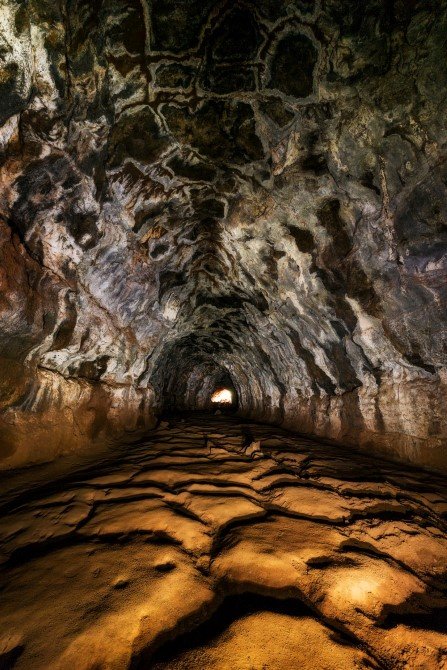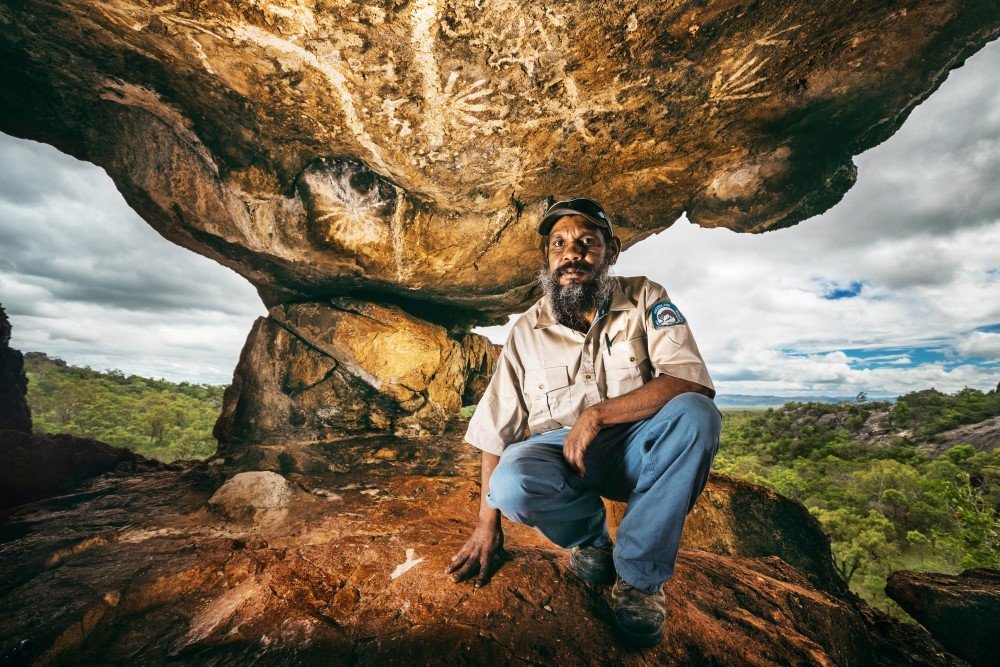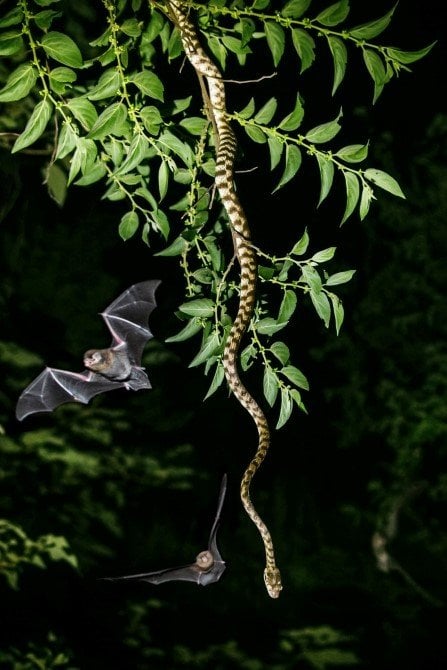Savannah caverns: Undara lava tubes

We’re standing at the mouth of a cave in Undara Volcanic National Park, 265km south-west of Cairns. It is mid-summer, an hour after sundown. There’s a soft breeze. Trees and vines hang overhead, silhouetted against the warm evening sky. By rights this should be a placid time on the savannah. Instead, it’s rush hour. Every opening in the leafy latticework above is an aerial expressway. Thousands of micro-bats are whirling past us into the night. Their frantic wing-beats fan our faces with musty cave air. The sound is incessant, a streaming white noise like the patter of rain on a forest canopy. To be amid this flapping exodus – channelled by the uncanny power of echolocation – feels sensational. And yet, something is missing. My guide, Liz Fisher, is puzzled. “I don’t understand it; they’re usually here by now,” she says, scanning the trees with the red glow of her torch. “Our snakes are running late.”
This is Barkers Cave, near the park’s western boundary. About 27km to the east sits the dormant Undara Volcano, its crater rim standing a paltry 20m above the surrounding plains. However, in vulcanism, elevation isn’t everything. Beginning 190,000 years ago, Undara erupted, not with a bang but a long, seething gush of lava. At times the rate of flow approached 1000 cubic metres a second. All up, Undara disgorged a colossal 23 cubic kilometres of molten mayhem. It spread across the plains and filled ancient river valleys to the brim. Over time, the lava atop these deeper valleys cooled to form a dark, hard crust. Meanwhile, below decks, the liquid lava – bubbling away at a ferocious 1200°C – kept surging downstream. In essence, as it moved on, the lava fabricated its own insulated pipeline. By the time Undara was a spent force its farthest run had travelled 160km.

In recent geology, no other single volcano on Earth has a longer lava flow. From the air this course is discernible today as a broken line of dense vegetation extending across sparse woodlands. These pockets of vine thicket sprout in moist depressions created by the collapse of sections of the lava tube’s roof. Where the lid remains intact, long stretches of hollow lava tube survive. Many resemble abandoned train tunnels. Others form archways interspersed with scree slopes and lush green courtyards. More than 60 of these relic caves have been explored. They’re geological powerhouses, daubed in colourful mineral oxides and etched with the scars of their fiery birth.
As well as housing the vine thickets, which are anchored by massive figs and kurrajongs, the tubes also serve as wildlife hideouts. They include the kilometre-long Bayliss Cave. Home to 52 resident animal species, it’s one of the world’s most biologically diverse caves. Among the mix are four of Undara’s species of insectivorous bats. Here at Barkers Cave the combined micro-bat population is 40,000-strong. With a moveable feast on this scale, predators are never too far away. And as it turns out Liz Fisher’s concerns are short-lived. It’s like someone’s thrown a switch. The sweep of her light suddenly picks out two, three and then four brown tree snakes, their pale yellow bellies glistening. With slender tails looped around branches they dangle head-fi rst into the main fl ight path, swaying centimetres from our faces. The bats keep on coming; the snakes wait, ready to strike.

The battle is on. It’s a test of nerves – for all of us. This life and death action plays out nightly throughout summer at Undara. Barkers is a maternity cave where bats congregate to nurse their young in this season of plenty. There are many craggy hidden gems out here on the edge of Queensland’s Gulf Country and the netherworlds of the lava tubes embody this mystique. Yet of all these secrets, the wild, pulsing energy of summer might just be the best kept. Liz’s boss, Bram Collins, agrees. He’s the straight-talking head of Undara Experience, the family business that guides visitors to the tubes from its resort close by.
“I don’t call it the wet season, I call it the green season,” he says. “The thing is, we’re just west of the Great Divide, 700m above sea level, yet on average there’s just 700mm of rain a year. So even in summer the nights cool down and you get plenty of clear days.” The Collins family knows a thing or two about these rhythms. They’ve been grazing cattle in the district since 1862. While the existence of ‘the caves’ was long-known, an increasing fl ow of visitors through the 1980s prompted Bram’s dad, Gerry, to branch into guided tours and hospitality.
“All he really wanted to do was protect the bush and give people a value-for-money experience,” says Bram. Tourism was a giant stride into the unknown for this no-nonsense cattle family. A quarter of a century on and hundreds of thousands of visitors later, Gerry’s vision is still going strong. Climb atop the granite tors near Undara Experience resort and the bold brushstrokes of these savannah highlands flow in every direction. As well as sighting tell-tale conical hills from the volcanic past, your gaze is led along timbered creek lines and plush green swamps to distant ranges hugging the horizon.
There’s much more to this canvas than termite mounds and lava tubes. For all its green-season garb, the brawny frame of the landscape is unmistakeable. Head west and the Great Dividing Range and its kin keep on flexing their geological muscle. Just beyond Mount Surprise, the ‘short cut’ track rambles south then west, linking up the old railway towns of Einasleigh and Forsayth. Their days as mining settlements are long gone, yet the bones of the land that lured prospectors – the outcrops, ridges and gorges – remain.


At 1284sq.km, Robin Hood station occupies a hefty block of terrain south of Forsayth. The Terry family have been running cattle here since 1964. Compared with the rich basalt tablelands of Atherton, this is lean, gritty country. It feels remote, even though it’s only a short hop from Forsayth. The Robertson River cuts through the heart of the station before it butts into a rugged natural fortress of sandstone. Here it makes a sharp dogleg to the north-west before joining the Gilbert River.
While there was knowledge of the ravines that slice into this craggy barrier, few had been explored since European settlement. That changed in 1992 when Simon Terry – the youngest of Cobb and Mary Terry’s seven children – got together with a couple of old schoolmates. Equipped with a tinny and an outboard, they headed upstream from a waterhole at the end of Cobbold Creek, a tributary of the Robertson River. To their astonishment they soon entered a dramatic sheer-sided chasm that kept wriggling its way deep into the sandstone country.
Two years earlier Simon and his wife, Gaye, had started operating the Howlong section of Robin Hood as part of a family agreement to divide up the station. “We only had a small number of cattle and it wasn’t really viable,” says Simon. The revelation of Cobbold Gorge sparked the idea of running tours. As he recalls: “One of the other guys on that trip said to me ‘You’ve got to take this seriously; this is unbelievable.’ We eventually got started in 1994. Gaye and I printed off a few flyers and dropped them off at the caravan parks on the highway. We had a full bus-load on our first day – and it’s just kept growing.”
As gorges go, Cobbold is a pup. For most of its life this creek joined the Robertson River via a wide watercourse some 15km upstream. However, at some point – and perhaps as recently as within the last 10,000 years – the flow was diverted into a slender gully heading north-east to the Robertson. Although the mechanism for this change of direction is open to debate, the end results are startling. The paperbark-fringed waterhole at the mouth of Cobbold Creek gives little away. Yet, cruise by boat another 200m upstream and the gorge walls loom large in vibrant ochres and deep chocolatey browns. Contrasting textures betray the alluvial origins of this Jurassic-period sandstone, with pebbly conglomerate layered between finer sediments. But what really makes this ravine captivating is its slender form. In the upper reaches it narrows to barely 2m across. Here the deeply sculpted faces start to overlap like teeth on a giant zip and as the boat creeps silently forward you can almost feel yourself breathing in.

Cobbold Gorge is but one feature in a vast sandstone stronghold. This blocky surface of weathered fissures and mushroom- shaped outliers has echoes of its cousins in the Kimberley and Arnhem Land. Walking up on top is like navigating a maze. Along with that enigmatic character comes the tantalising promise of more hidden gorges waiting to be discovered. In 2009 the Terry family established the 4720ha Cobbold Gorge Nature Refuge. Yet, as with the Collins clan at Undara, the essence of the place goes beyond recognition of natural assets. There is expansive history here. For these cattle families, embracing their geology and looking after people on their patch is another expression of the can-do ethos that sustained their forebears. Loyalty to the land is in their blood. As Simon Terry remarks, “For us it’s really empowering to be with a group who wants to enjoy the place and share in what we’re about.”
Further north at Chillagoe, these ties to geology go way back. Copper mining played a pivotal role in opening up the Gulf Savannah from the late 19th century and the rail line to Forsayth was part of an ambitious network created to support smelters at Chillagoe. Although the scheme only saw sporadic success, the rail link to Cairns lives on in the weekly run of the Savannahlander. Much of this historic route can also be closely followed by car. Ootann Road traverses 171km of sprawling grazing country north of Mount Surprise.
It’s a classic byway rolling through hill and scrub country and dipping into succession of stream crossings to reach Chillagoe. After the vivid, horizontal structures at Cobbold, nothing prepares you for the dark, jagged pinnacles that spear up around the small town of Chillagoe. These are the legacy of coral reefs that flourished here some 400 million years ago. After a tortuous history of folding and tilting, and prolonged erosion, this limestone has become an extravagant array of karst formations. Poking more than 40m from the plains, up close the weathered surfaces include sheer, fluted spires and perched terraces.
The Chillagoe-Mungana Caves National Park incorporates the bulk of the spectacular outcrops. Similar to Undara’s lava tubes, these rocky isles are precious refuges for semi-evergreen vine thickets. Protecting these habitats is a high priority for ranger-in-charge Mick Coburn. “One of our important practices is managing fire and weeds by an annual program of mosaic burning to introduce different aged grasses,” he explains. As striking as the karst landforms are, Chillagoe’s star attractions lurk below the surface. Sustained weathering by chemical action over many thousands of years has created myriad underground chambers and tunnels. “There are about 550–600 mapped cave entrances,” says Mick. “That probably equates to 300–350 caves…and no two are the same.”
Born and bred in Chillagoe, Mick spent most of his working life in the cattle industry; now in his role with the Queensland Parks and Wildlife Service, he’s been reunited with the subterranean realm that thrilled him as a kid. To spend time with Mick underground is to be with a bloke in his element, someone who’s fascinated by the formations, and firm about their protection. There is real heritage at stake here – public and personal. Later in our visit, another ranger, Eddie Thomas – a Wakamin man – takes us to a rock shelter perched high on a cliff overlooking the surrounding country. His life story is similar to Mick’s: a Chillagoe boy who spent long stretches away for school and cattle work, but who is now back for good. “This is my home; I always wanted to come back here,” he says. For Eddie too, these rocks of the savannah are more than geology alone. The shelter we’re sitting in was one of many limestone nooks where he visited and played as a young boy with his brothers and sisters. He remembers the old people talking to him here. And he points to the ceiling blackened by campfires and decorated with art. “Sometimes when you’re up here alone you get the feeling you’re not the only one here; you still got your family around you, like someone is watching.”
Essentials
When to go:
April to October is the most popular travel period. The ‘Green Season’ – December to March – brings lush growth and renewed wildlife activity. Check road conditions before travelling off-highway in summer. Note: Cobbold Gorge is closed between November and March.
Getting there:
Undara is a six-hour drive from Cairns via the Palmerston Highway and Savannah Way, or a four-hour drive via Gordonvale and the Atherton Tableland. Chillagoe is three hours from Cairns via Mareeba and the Wheelbarrow Way. Qantas flies daily from major cities to Cairns.
Where to stay:
Both Undara Experience and Cobbold Gorge offer a range of accommodation options, from ensuite cabins to caravan sites and camping. Chillagoe has motel-style rooms, cabins and camping. Caravan parks also feature in towns along the Savannah Way.
Points of interest:
1. Chillagoe-Mungana NP
2. Ootann Road
3. Millstream Falls
4. Forty Mile Scrub NP
5. Undara Volcanic NP
6. Savannahlander rail route
7. O’Briens Creek Gemfields
8. Forsayth
9. Cobbold Gorge
10. Agate Creek Gemfields




